Genode's Browser Odyssey
This article tells the twisted story behind Genode's native web browser, which is one of the most prominent achievements of the project during the past year. It is going to cover our motivation behind this undertaking, the rationale behind the choice of the browser engine, and many technical tidbits.
Before starting, let me give credits where credits are due. Most of the development described below was the work of my dear colleague Christian Prochaska, who relentlessly worked on the topic with a super-human level of patience. My role was for the most part watching in awe what he was doing.
Motivation
I think I'm not exaggerating when stating that the majority of application areas for computers and smartphones is covered by HTML5-based web applications, which are universally accepted by end users by now. By combining a modern web engine with Genode, we aim at making this wide variety of modern-day applications readily available on Genode. We are particularly interested in using those applications under Genode on the PinePhone.
However, this is anything but an easy feat because web engines are not only among the most complex software stacks, but also moving targets. We nevertheless took the challenge of re-targeting a complete HTML5 browser engine to the Genode OS framework. The breadth and depth of this line of work has yielded invaluable insights into the practical challenges when combining a state-of-the-art browser engine with microkernel-based operating system technology. With breadth, I refer to the scope of challenges ranging from taming highly complex build systems, over the comprehension of the entire POSIX API surface and the whole stack of protocol layers including the C runtime, networking, multiple application frameworks, up to web-application interfaces. With depth, I refer to the need to look behind the curtains of all those layers when troubleshooting issues, e.g., like investigating memory-corruption bugs in JIT-compiled Javascript code originating from a remote website.
Browser engines
The diversity of web-browser technology has dramatically decreased during the past decade. When it comes to modern open-source HTML5 engines that are compatible with the majority of modern web applications, there exist only three predominant competing implementations, namely WebKit developed by Apple, Gecko developed by the Mozilla Foundation, and Blink (Chromium) developed by Google.
Mozilla's Gecko engine has a history reaching back to 1997 when it formed the basis of the Netscape Navigator. Today, it largely remains as the technology behind the Firefox web browser and the Thunderbird email client. Gecko is an open-source project under the Mozilla Public License, which is a weak copyleft license in the spirit of the Apache license.
Apple's WebKit was originally based on the KHTML engine of the KDE project. In the years after the fork, it got widely adopted beyond Apple's products. For example, Qt4's HTML5 support used to rely on WebKit. Also early versions of Google's Chrome browser employed this engine. WebKit is an open-source project using the weak copyleft LGPLv2 license and the liberal 2-clause BSD license.
Google's Blink engine is the basis of the Chromium project, which in turn is the basis of the Chrome web browser. It originated as a fork of WebKit to foster Google's agenda to establish the browser as commodity runtime for end-user applications. Hence, Chromium introduced functionality that was previously considered as the domain of operating systems, e.g., sandboxing, hardware-accelerated graphics (WebGL), webcam support, or audio. Chromium is an open-source project using mostly the liberal 2-clause BSD license.
Today, Chromium is by far the most widely used browser engine. It has a market share of more than 60%. Apple's WebKit remains mostly used by Safari and iOS with a market share of around 20%. In contrast, the market share of Mozilla's Gecko engine had dropped below 10%.
The predominance of Chromium eventually prompted Microsoft to replace their former in-house-developed Internet Explorer with the Chromium-based Edge browser for the Windows operating system. As another former browser-engine vendor, Opera adopted Blink as the basis of their current offerings.
Given the dominant market share of Chromium, developers of web applications increasingly focus their development and testing efforts on this single implementation. In fact, web applications are anecdotally known to work best on Chromium-based browsers.
This consolidation is a two-edged sword. On the one hand, given that Chromium is an open-source project, it gives users and developers more freedom compared to the proprietary browser engines of the past. On the other hand, this technology is ultimately defined and controlled by a single vendor, which drives its development. Chromium is a combination of a fast-moving target and extremely high complexity. Because of Google's investment, the mind share behind the technology is effectively centralized and follows the corporate interests of the company. The complexity of the technology - regardless of its open source license - makes a community-governed fork practically impossible.
To illustrate the latter point, Chromium consists of more than 17 million lines of source code (sloccount, not counting comments or white space), which is close to the entirety of the Linux kernel including all drivers and CPU architectures. In contrast to Linux, however, the direction of Chromium is controlled by a single vendor. To put those numbers into perspective, in terms of source code, the Chromium browser is around 50 times larger than the entire Genode operating-system project (with all of the more than 250 components combined).
Even though the near-monopoly position of Google in the browser space is unfortunate, there is no realistic alternative to Chromium for pursuing our goal to host a large share of popular applications on Genode, with low friction for the end user. So we had to accept the challenge to bring Chromium to life on top of Genode.
Porting spree
Our starting point was the Qt application framework. Qt is a popular and rich cross-platform application framework including a graphical widget tool kit and abstractions for the interaction between application software and the underlying operating system. Applications developed using the framework can be targeted at all platforms supported by Qt, which include Linux, Windows, and Mac OS X.
Since more than 10 years, the Genode OS Framework supports the integration of Qt-based applications into Genode-based systems. The Qt framework is equipped with bindings for many popular open-source libraries. In particular, Qt version 4 supported bindings to the WebKit browser engine, which ultimately enabled us to bring the WebKit-based Arora browser to Genode in 2010.
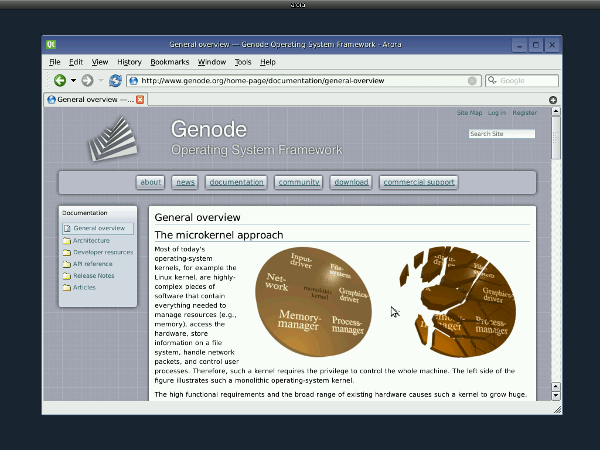
|
|
The WebKit-based Arora browser running on Genode version 10.05.
|
The feature set and dominance of Chromium prompted the Qt project to replace WebKit by the Chromium engine in Qt 5.4 in 2014. The integration of the Chromium engine in Qt5 is called QtWebEngine. However, for Genode's Qt5 port, we used to disregard QtWebEngine as too complex. Whereas WebKit comprised 1.8 million lines of code, QtWebEngine is literally 10 times larger.
However, now, with the goal of enabling the Chromium engine on Genode set, QtWebEngine looked like an attractive and attainable path forward, which would in principle allow us to reuse our existing integration of Qt with Genode for the browser's graphical user interface.
Building from source for a known-to-work platform
To get acquainted with Chromium, we first took the beaten track of building QtWebEngine for one platform officially supported by the Qt project, namely Linux. For testing the result, we used a minimal browser example that comes shipped with Qt.
The complexity of the Chromium code became immediately apparent. Even though we disabled a number of default features like geolocation, printing, PDF support, spell checking, WebRTC, or proprietary media codecs, our development machine equipped with a 16-core AMD EPYC 7302P processor took almost one hour to build QtWebEngine using -j32. The resulting libQt5WebEngineCore library has a stripped size of 132 MiB (741 MiB with debug information), which is by far the biggest build artifact we ever encountered.
FreeBSD and Linux/ARM64 as intermediate targets
Genode's C runtime is based on FreeBSD's libc, which is subtly different from the glibc predominately used on Linux-based operating systems. To rule out incompatibility issues early on, we decided to first try building and using QtWebEngine on FreeBSD. Note that FreeBSD is not officially supported. But fortunately, a patch set maintained by the FreeBSD community exists. Using the FreeBSD build, we could gradually strip down the external dependencies to only fontconfig and the nss library, both of which we manually disabled. The working build result on FreeBSD reinforced our confidence that a Genode build of QtWebEngine is in principle attainable.
A second source of uncertainty was the unknown compatibility and performance of QtWebEngine on the 64-bit ARM architecture. To assess the risk, we built and tested the minimal browser example for Linux on the i.MX8 EVK board, which worked fine.
Up until this point, all builds had been performed on target. When targeting Genode, however, we have to cross compile. To rule out possible cross-compiling issues and to find out the right hooks for passing compiler flags, we built the FreeBSD version of QtWebEngine on Linux and tested the result on FreeBSD on ARM64. Fortunately, we found that Qt's qmake build tool has a solid support for cross-compiling via configuration files (mkspecs).
The experiment to cross-compile QtWebEngine for FreeBSD/ARM64 on Linux required us to create a custom mkspecs definition, which gave us the insights needed later for targeting Genode, e.g., the hooks for specifying the name of the tool chain. Further ingredients needed for the cross compilation were the FreeBSD headers and libraries, which we supplied by mirroring the corresponding directories from FreeBSD. Once the build succeeded, we were able to further reduce the gap towards Genode by gradually removing all FreeBSD headers not present on Genode. Whenever the removal of a header yielded a build failure, we patched the corresponding code and were able to immediately test the result on FreeBSD, walking on stable ground.
Targeting Genode
Up to recently, the porting of software to Genode was generally conducted by transplanting the build rules for the 3rd-party software into Genode's build system. The complexity of Chromium, however, immediately rules out this traditional porting approach. So we picked up an alternative idea we investigated in the recent past.
End of 2019, we started exploring the alternative approach of re-using 3rd-party build systems to attain Genode executables via a custom meta-build tool called Goa. Goa invokes 3rd-party build systems while supplying the right parameters for using Genode's tool chain, compile flags, headers, and linker scripts in order to attain Genode-compatible executables. Initially, we successfully applied the approach to CMake based build systems as well as Autoconf-based projects.
Inspired by the promising results of Goa, we started using qmake in the same fashion, specifically by steering the build using a Genode-specific mkspecs definition. Once we attained working build results for Qt's base libraries like QtCore and QtGui, we turned our attention to QtWebEngine.
The qmake-based build of QtWebEngine, in turn, invokes the Ninja build system used by the Chromium project. This cascaded use of build systems was not without trouble. We had to investigate the interplay between qmake and ninja to determine compile flags that were unexpectedly not passed correctly to ninja. E.g., we had to supplement the definition of ninja's extra_cflags and extra_cxxflags from the corresponding QMAKE_CFLAGS and QMAKE_CXXFLAGS.
Chromium relies on almost all facets of the standard C++ library, some of which were not covered by Genode (std::thread, std::mutex). We either disabled the corresponding code portions or supplemented the missing bits to Genode's standard C++ library.
The ultimate result of this work was an executable binary along with the shared libraries for Qt5 and QtWebEngine that were presumably compatible with Genode.
Runtime environment
With the principle way of creating executable binaries for the browser and its libraries in place, the next step was running the binaries on top of Genode. At this point, Genode's cross-kernel ABI compatibility became an indispensable asset, which enabled us to test the initial operation of the browser on Linux using regular debugging tools like the GNU debugger.
To name a few hurdles we had to address:
-
Genode's naming of shared libraries *.lib.so differs from the conventional lib*.so pattern.
-
The size of the QtWebEngine library exceeded Genode's so-called linker area, which is a range of the virtual address space preserved for loading ELF binaries. This prompted us the increase Genode's linker area from 256 MiB to 400 MiB across all platforms.
-
Genode's C runtime used to have an artificial limit of the maximum number of atexit handlers due to the use of a static array. Chromium exceeded this limit by a wide margin, which prompted us to revise Genode's atexit handling, eventually removing the limit.
-
Chromium uses shared memory areas established by using mmap with the MAP_SHARED flag for exchanging data with a render thread, which is normally executed as a distinct process. Genode's C runtime has no notion of MAP_SHARED. We tackled this problem by emulating MAP_SHARED via a dedicated VFS plugin and by co-locating the render thread with the browser process.
-
With those issues addressed, the minimal browser started to show its first life signs but behaved rather erratically, crashing or displaying erroneous graphical artifacts. Most crashes resulted from thread-safety issues of Genode's version of getaddrinfo. The graphical artifacts resulted from the missing MSG_PEEK support in Genode's version of recv. The combination of the enormous complexity, the indeterministic nature of race conditions, and memory corruption made these issues extremely hard to find. Once spotted, the fixes were relatively straight-forward.
With the minimal browser example working, we turned our attention to building and packaging the Falkon browser based on QtWebEngine. Thanks to the integration of QtWebEngine with Qt's widget set, this initial version of Genode's Falkon port immediately appeared as a fairly complete web browser.
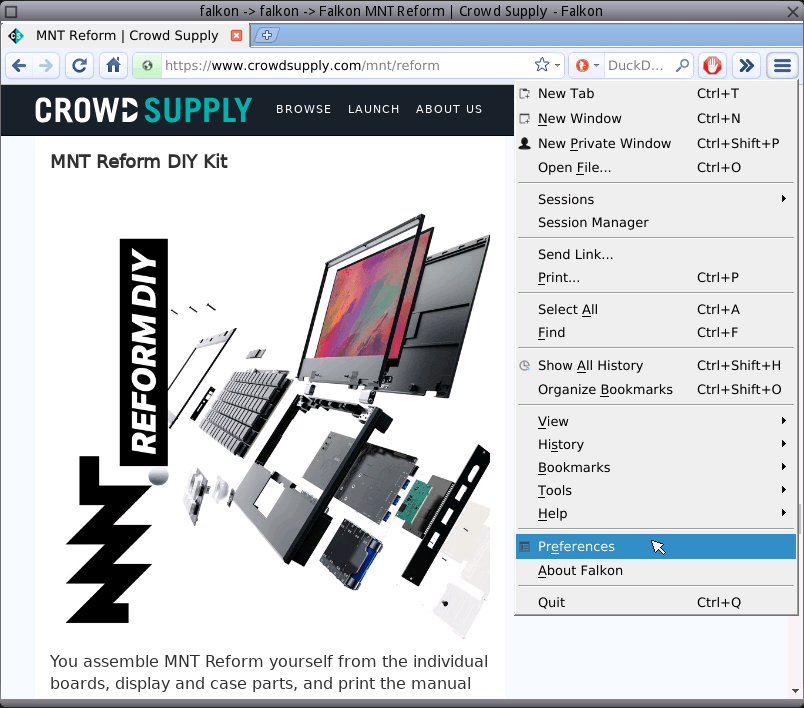
|
|
Early version of the port of the Falkon browser running on Genode
|
At this point, we started the first baby steps for creating the 64-bit ARM version of the minimal browser, which predictably triggered a different set of problems. Given our experience with Java's JIT compiler with ARM's weak cache coherency, we expected similar problems with Chromium's Javascript engine. We found that Chromium invokes mprotect as a mechnism to invalidate the instruction cache. So we mapped those calls to Genode's cache maintenance operations. With this problem solved, the minimal browser started successfully on 64-bit ARM, albeit running very slowly. The subsequent step of compiling the Falkon browser for 64-bit ARM too, succeeded with no further showstoppers.
Corner cases, testing, optimization
With the initial version of the browser working, we started testing by using it directly on Genode's Sculpt OS and thereby discovered several corner cases and observed the severe need for optimization.
For example, we found that the browser frequently obtains random numbers by accessing /dev/urandom, which we backed by the jitterentropy-based random number generator. Those random numbers are computationally fairly expensive. We could relieve the issue by combining jitterentropy with a cheap pseudo RNG (jitter_sponge).
Furthermore, we optimized the select mechanism of Genode's C runtime as well as the access of pthreads to sockets. Several related libc internal mechanisms received optimizations, in particular the access to thread-local storage and process-local inter-pthread synchronization.
One break-through realization was the dimensioning of the memory limit of the Javascript engine, which happens to be determined by getrlimit. Genode's version of this function did not return a meaningful value for RLIMIT_DATA, which resulted in a overly tight limit, severely impeding the performance and stability.
Functionality-wise, we had to enable libnss for Genode, which is used by Chromium for the validation of SSL certificates.
Most video-streaming sites deliver mp4 streams, which our version of Falkon did not support. To generally support media playback, we had to enable QtWebEngine's proprietary codecs.
Even with the proprietary codes enabled, we faced a long standing issue with accessing YouTube on ARM. The Javascript engine would crash not long after YouTube presented its cookie-confirmation dialog. Our investigation led us into the inner guts of the Javascript's JIT compiler, which produced binary code with inter-thread synchronization issues. We ultimately found that the problematic code is actually never used in the Linux version of Falkon. It turns out that the difference was caused by the optimization webengine-v8-snapshot. Early on during our porting effort, we deliberately disabled this optimization to ease our life. With the optimization enabled, frequently used Javascript code is pre-compiled at the compilation time of the browser. The pre-compiled code works correctly. With the optimization disabled, the problem occurs on Linux as well. Hence we could side-step the problem by enabling the optimization.
With this road block removed, we could finally celebrate playing YouTube videos on Genode.
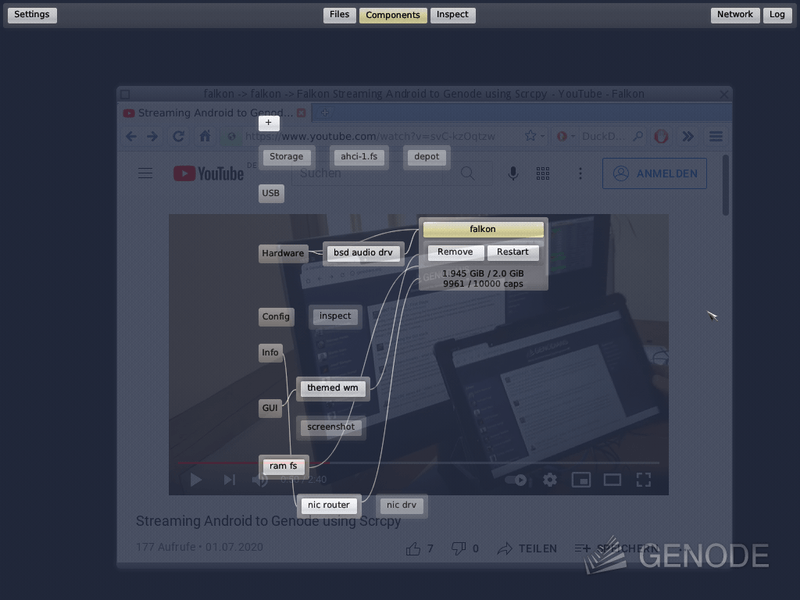
|
|
The Falkon web browser playing a YouTube video on Sculpt OS
|
Media interfaces
With our aspiration to use Falkon on Genode for video-chat scenarios, we investigated the means to integrate the browser's media facilities with Genode's corresponding interfaces. We had three areas of interest, audio playback, audio capturing, and video capturing. Our goal is to keep our port of the browser as little invasive as possible to ease future updates of the QtWebEngine. Hence, instead of enhancing the browser with Genode support, we instead prefer to emulate existing and time-tested interfaces already supported by the browser.
For audio, Genode already features an emulation of the OSS (open sound system) API in the form of a so-called VFS plugin. It transparently translates an application's interaction with a /dev/dsp pseudo device to Genode's native audio interfaces. The browser employs a library called sndio that features a number of audio backends, with OSS being one option. Hence, sndio conveniently bridges the gap between Genode's OSS emulation and the browser's audio facilities.
In the same spirit, we investigated possible options for video capturing and found three potential hooks, namely Video4Linux, fake (auto-generated test animation), or supplying a video file containing YUV pixel data as command-line argument. None of those options met our desire for a simple solution that could be easily integrated with Genode's existing capture session interface. However, thanks to the variety of video-capturing back ends that we could take as blue prints, it was relatively simple to supplement our own implementation.
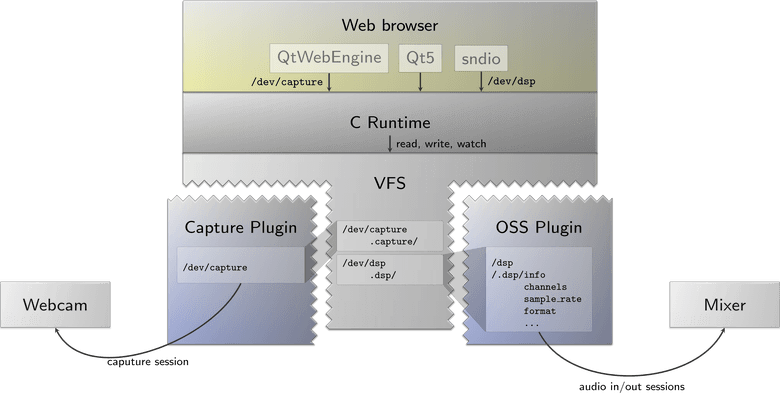
|
The image above illustrates the interplay of the browser with the pseudo devices provided by plugins for Genode's virtual file system. Thanks to this architecture, the Genode world remains cleanly separated from the POSIX world on top.
With respect to video capturing on Genode, the capture service is provided by a clever combination of components depicted below. A second instance of the nitpicker GUI server is used as a video bridge between the USB webcam driver and the browser. Both parties connect to this nitpicker instance, which naturally controls the data path of the video stream. Hence, the capturing of the camera is completely decoupled from the browser.

|
|
Data path between the webcam and the web browser
|
In fact, the USB webcam subsystem that we added in the 21.10 release of Sculpt OS, a disposable webcam driver is started and removed on demand depending on the presence of a capture client. This architecture ultimately clears the way to implement a camera kill switch that is out of reach of the (untrusted) browser, putting the user into the position of ultimate control over the camera.
Regarding the capturing of audio data, we unfortunately found the sndio backend of the QtWebEngine underdeveloped. Even after updating the backend to a more recent version that presumably features audio capturing via sndio, we were unable to attain workable results.
We ultimately decided to sidestep sndio by a custom written OSS backend that is specifically geared to the feature set provided by Genode's OSS emulation, largely avoiding complexity. With the custom OSS backend in place, we reached the principle functionality needed for video chat. Even though further optimization steps are needed for real-world use beyond technical demonstrations, the path towards using WebRTC-based video chat on Genode is cleared.
Current state
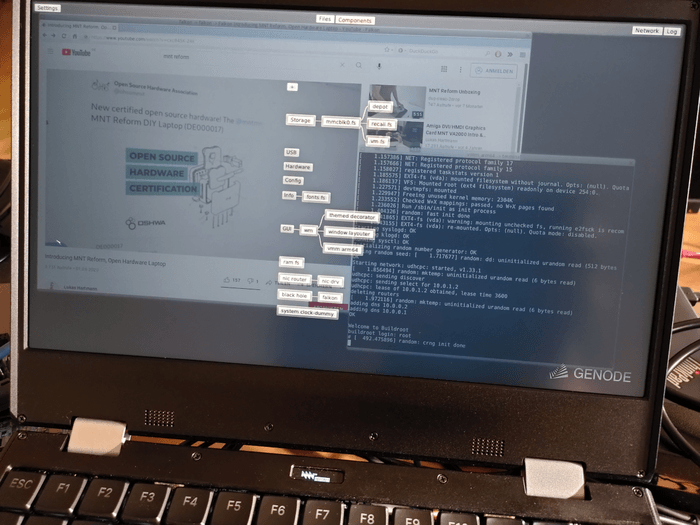
|
|
The Chromium-based Falkon web browser running on the 64-bit ARM MNT-Reform open-hardware laptop
|
Web-applications survey
As stated in the introduction, we pursued this challenging line of work in the hope to bring the wealth of modern web applications on Genode. We are happy that this claim came to fruition. In fact, we were able to use plenty of web applications in Genode's version of the Falkon web browser on Sculpt OS running on our regular laptops.
-
Editing documents using Google docs
-
Accessing E-Mail using Gmail and GMX
-
Using Google maps
-
Shopping on Amazon
-
Creating diagrams using https://draw.io
-
Interacting with collaboration solutions via https://try.nextcloud.com
-
Playing videos on YouTube
-
Using Github
Since having integrated the web browser into the Genode-based Sculpt OS, using the browser has become daily routine for us Genode developers, which I would call a resounding success.
State of the media features
We are currently in the process of maturing the browser's media capabilities by connecting the browser's media back ends to corresponding Genode services, most notably an audio driver (on x86 PC hardware) and a USB webcam driver on both ARM and PC hardware. Although we are happy to see the media features working in principle, we are not there yet, evidenced by audible distortions and latencies. Given the heavy work load and complexity of the browser, this is not surprising. To follow our ambition to host WebRTC-based video-chat scenarios on the resource-constrained PinePhone, however, we need to deeply understand and optimize those non-functional aspects. That's our motivation behind emphasizing quality-of-service topics on Genode's recently published road map for 2022.
Interactive performance
We tested the browser on PC hardware as well as on 64-bit ARM hardware - specifically NXP's i.MX8 SoC - on Sculpt OS.
On PC hardware, the browser's interactive performance is perfectly usable. Even heavy-weight websites like heise.de can be visited and scrolled without lagging. The user experience on ARM, however, is not satisfactory yet. The browser visibly overstresses the system. Even though it is functional, the response to user input has a perceivable latency and scrolling stutters.
From cross-correlating Genode's version of Falkon with the same browser running on Linux, we learned that the performance of the ARM platform is not smooth in both cases. Genode's version of the browser is not far off the performance observed on Linux. However, we also observed that the Chromium browser (not Falkon) is able to attain a smooth performance on the same ARM platform. These tests hint at a promising potential for further optimization. In particular, the comparison of Falkon vs. Chromium on Linux hints at possible friction due to the integration of Chromium with Qt. It is tempting to investigate the interplay of Qt and Chromium - especially the response to user-input events - in detail.
On both PC and ARM hardware, we observed the networking throughput as a bottleneck, in particular on websites that trigger a large number of TCP connections. Hence, Genode's TCP/IP protocol stack and its interplay with the C runtime looks like a rewarding optimization vector.
Furthermore, we observed a noticeable effect of file-system used for the browser cache. Using an in-memory file system yields a visibly improved interactive performance over the use of a persistent file system, which we found surprising. Profiling the file-system access patterns of the browser might reveal further optimization opportunities.
Finally, the use of multiple CPU cores has significant effects. The browser is a heavily multi-threaded application. Even with a moderately complex website like heise.de, the browser spawns over 40 threads. When spanning this workload over all four CPUs of the ARM platform, the inter-CPU cross-talk of the threads impedes the performance. On the other hand, the performance of only a single CPU does not suffice for an enjoyable user experience. We found the use of two CPUs - both distinct from the boot CPU - to be the sweet spot. However, the significant influence of the CPU resource partitioning hints at an untapped potential for optimization, either by pinning tightly coupled threads to individual CPUs according to prior knowledge or by balancing CPU loads dynamically.
Many tempting topics to work on...
Caveats
The scope of web applications that immediately worked without flaws on Genode's version of the Falkon web browser is positively surprising. However, while test-driving WebRTC clients - in particular Jitsi - we already experienced the browser as a steadily moving target. Depending on the combination of browser versions and Jitsi versions, establishing a bi-directional video chat was a hit-and-miss experience. The best results could be obtained by hosting a controlled instance of Jitsi with a known-to-work version whereas the official version hosted at https://meet.jit.si behaved rather erratically. E.g., the press of the button to join a chat would not be recognised with the version of Chromium we are using. This is notably not an issue of our port of the Falkon browser but can be reproduced on the upstream version of the browser on commodity Linux systems as well. Similar erratic behavior could be observed when using Firefox on Linux.
From these observations, we take that the implementation of the web standards that underpin current WebRTC-based solutions are anything but stable. In contrary, the solutions seem to be tied to most recent browser versions. Browsers must be continuously updated in order to uphold functionality, which brings us back to the tight dependency on a single vendor as discussed in the introduction.
Future
There are two possible avenues to counter the moving-target nature of browser-based WebRTC solutions. First, by hosting a known-to-work version of the server software inside a (virtual) private network, i.e., secured via Wireguard. Second, by keeping up Genode's version of the browser with the upstream version of Chromium. It goes without saying that the latter requires continuous effort.
Our future will be a mix of both approaches. Thanks to the way of how we interfaced the browser with Genode - largely without code modifications of the browser - we expect browser updates to stay economically viable when pursued at bi-annual intervals. Unfortunately, the nature of the browser as a moving target comes with the risk of regressions, which cannot be ruled out and may require unplanned debugging and testing efforts. We have to accept this risk.
For the reliable collaboration of a closed group, a fixed and known-to-work combination of a browser version and server version, protected by a VPN, is an attractive alternative because regressions cannot occur. When employing Genode's strong sandboxing capabilities combined with a secure VPN solution, the use of a slightly outdated browser version as a WebRTC appliance strongly sandboxed by Genode, does not pose a risk. We do not trust the browser anyway, after all. We plan to pursue this direction by combining the Wireguard VPN solution with Genode.
Have I mentioned that Wireguard is featured on our road map for this year?


 Norman Feske
Norman Feske